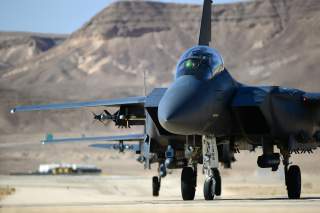One of America's Most Powerful Fighter Jets Is Getting a New Bomb
The U.S. Air Force completed a series of rigorous, high-speed wind tunnel tests for the Small Diameter Bomb II.
The SDB II also has the ability to classify targets, meaning it could for example be programmed to hit only tanks in a convoy as opposed to other moving vehicles. The weapon can classify tanks, boats or wheeled targets, Raytheon officials added.
U.S. Air Force completed a series of rigorous, high-speed wind tunnel tests for Small Diameter Bomb II, moving the weapon one step closer to deployment on an F-15 by 2018 integration on the Joint Strike Fighter. SDB II can destroy moving targets in all weather conditions at ranges greater than 40 miles -- a Raytheon statement said.
The Air Force is engineering and testing a new air-dropped weapon able to destroy moving targets in all kinds of weather conditions at ranges greater than 40-miles, Air Force and Raytheon officials said.
The Small Diameter Bomb II, or SDB II, is designed to destroy moving targets in all kinds of weather, such as small groups of ISIS or terrorist fighters on-the-move in pickup trucks.
Recommended: 5 Reasons No Nation Wants to Go to War with Israel
An Air Force F-15 Eagle has destroyed a moving surrogate-model T-72 tank during a live-fire test of the new Small Diameter Bomb II at White Sands Missile Range, N.M.
Raytheon officials explained that the surrogate T-72 tank was moving at tactically relevant battle speeds when it was destroyed by the SDB II during the live-fire test.
Recommended: 5 Worst Generals in U.S. History
Most of the testing of the SBD II thus far has been on an Air Force F-15 Eagle Fighter Jet, however the weapon has also been fitted and tested on the F-35 Joint Strike Fighter.
The new bomb is slated to be operational on F-15E fighter jets by 2018, Raytheon and Air Force officials said.
Recommended: Could the Battleship Make a Comeback?
“It is making good progress. It is moving along well in its test program. We started the first Low Rate Initial Production for 144 weapons back in June(2015). The threshold platform is the F-15E. The Navy is looking at integrating that on the F-18,” Lt. Gen. Arnold Bunch, Air Force Military Deputy for Acquisition, told Scout Warrior in an interview a few months ago.
A weapon of this kind would be of extreme relevance against ISIS fighters as the group is known to deliberately hide among civilian populations and make movements under cloud cover or adverse weather in order to avoid detection from overhead surveillance technologies.
While the Air Force currently uses a laser-guided bomb called the GBU-54 able to destroy moving targets, the new SDB II will be able to do this at longer ranges and in all kinds of weather conditions. In addition, the SDB II is built with a two-way, dual-band data link which enables it to change targets or adjust to different target locations while in flight.
The SDB II could be operational on an F/A-18 Super Hornet by 2020, Raytheon officials said.
Engineers are also working on plans to integrate the bomb onto the F/A-18E/F Super Hornet and F-16 as well, Raytheon officials said.
GPS and laser-guided weapons such as Joint Direct Attack Munitions have been around for decades, however, they have primarily been designed for use against fixed or stationary targets.
A key part of the SDB II is a technology called a “tri-mode” seeker — a guidance system which can direct the weapon using millimeter wave radar, uncooled imaging infrared guidance and semi-active laser technology.
A tri-mode seeker provides a range of guidance and targeting options typically not used together in one system. Millimeter wave radar gives the weapon an ability to navigate through adverse weather, conditions in which other guidance systems might encounter problems reaching or pinpointing targets.
Imagining infrared guidance allows the weapon to track and hone in on heat signatures such as the temperature of an enemy vehicle. With semi-active laser technology, the weapon can be guided to an exact point using a laser designator or laser illuminator coming from the air or the ground.
Also, the SBD II brings a new ability to track targets in flight through use of a two-way Link 16 and UHF data link, Raytheon officials said.
The millimeter wave radar turns on first. Then the data link gives it a cue and tells the seeker where to open up and look. Then, the weapon can turn on its IR (infrared) which uses heat seeking technology, Raytheon officials said.
The SBD II is engineered to weigh only 208 pounds, a lighter weight than most other air dropped bombs, so that eight of them can fit on the inside of an F-35 Joint Strike Fighter, Raytheon officials explained.
If weapons are kept in an internal weapons bay and not rested on an external weapons pod, then an aircraft can succeed in retaining its stealth properties because the shapes or contours of the weapons will not be visible to enemy radar.
About 105 pound of the SDB II is an explosive warhead which encompasses a “blast-frag” capability and a “plasma-jet” technology designed to pierce enemy armor, Raytheon officials explained.
The SDB II also has the ability to classify targets, meaning it could for example be programmed to hit only tanks in a convoy as opposed to other moving vehicles. The weapon can classify tanks, boats or wheeled targets, Raytheon officials added.
The potential value of the entire SDB II production run is expected to be $2.792 billion for 17,000 SDB II weapons – 12,000 for the Air Force and 5,000 for the Navy, Air Force officials said.
This first appeared in Scout Warrior here.

